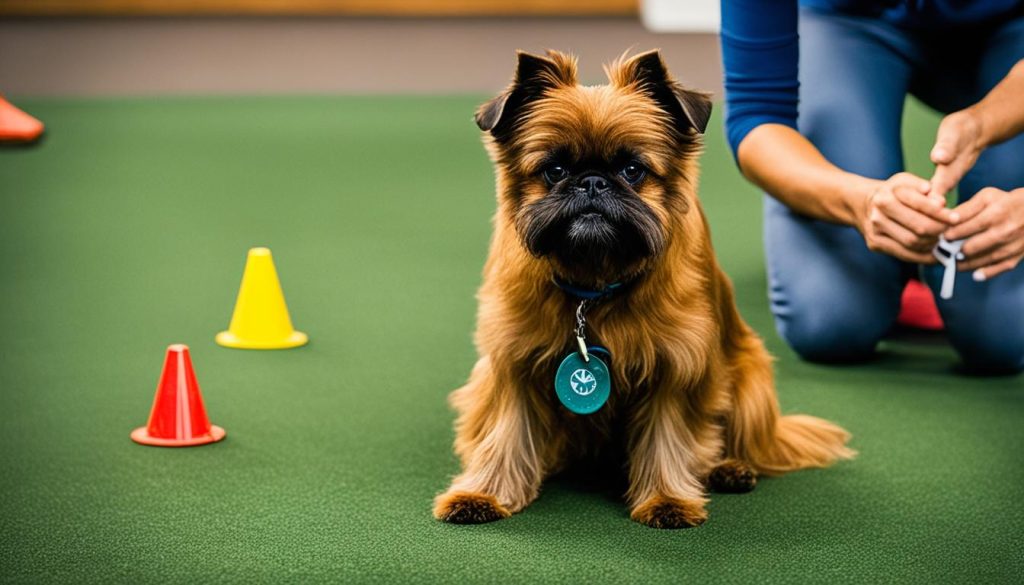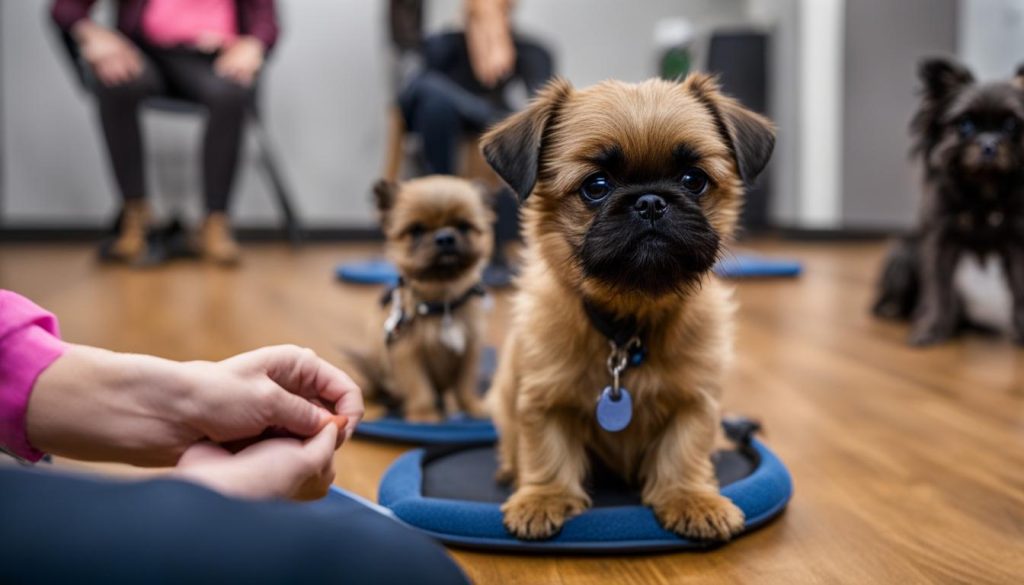Training a Brussels Griffon can be a rewarding experience for both you and your furry companion. With the right techniques and strategies, you can enhance your Griffon’s obedience and behavior. In this article, I will share proven tips and methods for successful Brussels Griffon training.
Brussels Griffon Training: Discover Helpful Techniques
- Positive reinforcement is vital for effective Griffon training.
- Teaching tricks can enhance the bond between you and your Griffon.
- Establishing a structured training routine is crucial for success.
- Socialization and behavior modification play key roles in training.
- Patience, consistency, and regular practice are essential for desired results.
Understanding the Brussels Griffon
The Brussels Griffon is a small companion dog breed known for its intelligence and loyalty. When it comes to training a Brussels Griffon, understanding their unique characteristics and behaviors is crucial for success. These dogs are highly trainable and respond exceptionally well to positive reinforcement techniques. Teaching tricks and obedience commands can be a fun and engaging way to train your Brussels Griffon, while also strengthening your bond with them.
Positive reinforcement training methods involve rewarding desired behaviors with treats, praise, or playtime. This approach helps to reinforce good behavior and encourages your Griffon to repeat it. By focusing on positive reinforcement, you can effectively modify any unwanted behaviors that your Brussels Griffon may exhibit. This method not only keeps the Brussels Griffon training experience enjoyable for your furry friend but also cultivates a strong and loving relationship.
To get started with Brussels Griffon behavior training, begin by identifying specific tricks or commands you want to teach your dog. Basic obedience commands such as sit, stay, and come are a good place to start. When training, use clear and consistent cues to communicate your expectations to your Griffon. Break down complex tricks or commands into smaller, manageable steps to ensure your dog understands what is being asked of them.

Training sessions should be kept short and engaging, ensuring that your Brussels Griffon remains motivated and focused. Incorporate rewards and positive reinforcement to help your dog stay engaged and eager to learn. Remember to be patient and understanding during the Brussels Griffon training process, as different dogs learn at different paces.
In addition to teaching tricks and obedience commands, Brussels Griffon behavior training should also address any specific challenges or issues your dog may have. With positive reinforcement methods, you can effectively modify behaviors such as excessive barking, jumping, or leash pulling. By consistently rewarding desired behaviors and redirecting unwanted ones, you can help your Griffon become a well-mannered and obedient companion.
Understanding the unique characteristics of Brussels Griffons is essential for successful training. Utilizing positive reinforcement techniques, teaching tricks, and addressing specific behavioral challenges will help you develop a well-behaved and happy Brussels Griffon. By building a strong bond through training, you and your furry friend can enjoy a rewarding and harmonious relationship.
Creating a Structured Training Routine
Establishing a structured training routine is crucial for successful Brussels Griffon obedience training. Consistency and repetition are key to reinforcing desired behaviors and discouraging unwanted ones. By setting clear rules and expectations, you can help your Griffon understand their role in the household hierarchy.
Training sessions should be short and focused, incorporating effective Brussels Griffon training techniques, positive reinforcement, and rewards. These techniques can include using treats, praise, and playtime as incentives to motivate your Griffon. By consistently practicing these techniques at home, you can achieve significant obedience and behavioral improvements in your Brussels Griffon.
When creating your Brussels Griffon training routine, consider the following tips:
- Set a consistent schedule for training sessions to establish a routine that your Griffon can rely on.
- Keep training sessions short and engaging, as Griffons tend to have shorter attention spans.
- Focus on one command or behavior at a time to prevent overwhelming your Griffon.
- Use positive reinforcement techniques, such as verbal praise and reward, to reinforce good behavior.
- Be patient and consistent in your training efforts, understanding that every Griffon learns at their own pace.
Remember, Brussels Griffon obedience training is a journey that requires time and effort. By implementing a structured training routine and utilizing effective techniques tailored to your Griffon’s needs, you can ensure successful training outcomes.
Implementing a structured training routine can be a game-changer for training a Brussels Griffon at home. While it may take time and patience, the results will be worth it. Stay consistent, use effective training techniques, and watch your Griffon flourish into a well-behaved and obedient companion.
Socialization and Behavior Modification
Socialization plays a crucial role in the training of Brussels Griffons. By exposing your Griffon to various environments, people, and other animals from an early age, you can help prevent shyness and fearfulness in your furry companion. This is an essential step in ensuring that your Griffon grows up to be a well-rounded and confident dog.
Moreover, behavior modification techniques can be employed to address specific issues that your Brussels Griffon may exhibit, such as resource guarding or separation anxiety. It’s important to understand the underlying causes of these behaviors and approach them with patience and positive reinforcement.
One effective method of behavior modification is clicker training. Clicker training involves using a small handheld device that emits a distinct sound (the click) to mark and reinforce desired behaviors. By pairing the click with a reward, such as a treat or praise, you can effectively communicate to your Griffon what actions are desirable.

House training is another crucial aspect of training your Brussels Griffon. Consistency is key when it comes to house training, so establish a routine and stick to it. Take your Griffon outside frequently, especially after meals and naps, and reward them with praise and treats when they eliminate in the appropriate spot. With patience and persistence, your Griffon will learn where and when it’s acceptable to relieve themselves.
Tips for Successful Brussels Griffon Training
Training a Brussels Griffon puppy requires patience and consistency. To ensure effective Griffon training, it is important to start with basic obedience commands such as sit, stay, and come.
Use positive reinforcement techniques during your training sessions. Reward your Griffon with treats, praise, and playtime when they successfully follow your commands. This positive feedback will motivate them to continue behaving well.
When training a Brussels Griffon, it is essential to strike a balance between being firm and gentle. Griffons are sensitive dogs and respond best to positive reinforcement rather than harsh or punitive methods.
In addition to obedience training, make sure to provide regular exercise and mental stimulation for your Griffon. A tired and mentally stimulated dog is less likely to display behavioral issues and more likely to excel in their training.
Remember that every Brussels Griffon is unique, so tailor the training methods to fit their individual needs and personality. Observe their learning style and adjust your approach accordingly.
For successful Brussels Griffon puppy training, keep these tips in mind and enjoy the journey of nurturing a well-behaved and happy companion.
Conclusion
Training a Brussels Griffon can be a fulfilling and rewarding experience that strengthens the bond between you and your furry companion. By understanding the unique characteristics of Brussels Griffons and using effective training methods, you can ensure that your Griffon is well-behaved and happy.
Consistency is key when it comes to training a Brussels Griffon. Regular practice and patient reinforcement of desired behaviors will yield the best results. Take the time to teach your Griffon basic obedience commands and address any specific behavior problems using positive reinforcement techniques.
Remember, training is a journey that requires dedication and love. By following the training tips provided in this article, you will be equipped with the best techniques to guide your Griffon towards becoming a well-adjusted and obedient member of your family. With your commitment and the right training methods, your Brussels Griffon will grow into a happy and well-behaved companion.
FAQ
How do I train a Brussels Griffon?
Training a Brussels Griffon involves using positive reinforcement techniques such as rewards and praise. Consistency and repetition are key to reinforcing desired behaviors and discouraging unwanted ones. Establishing a structured training routine and providing regular exercise and mental stimulation are also important.
What are the unique characteristics of Brussels Griffons that I should consider during training?
Brussels Griffons are highly trainable and respond well to positive reinforcement methods. They are intelligent and loyal, but can be sensitive, so it is important to be firm but gentle during training. Socialization from an early age can help prevent shyness and fearfulness.
How do I create a structured training routine for my Brussels Griffon?
To create a structured training routine for your Brussels Griffon, set clear rules and expectations. Keep training sessions short and focused, incorporating positive reinforcement techniques and rewards. Consistency is key to reinforcing the desired behaviors and establishing a strong bond with your Griffon.
How can I address behavior problems and socialize my Brussels Griffon?
Behavior modification techniques, such as positive reinforcement training and clicker training, can be effective in addressing specific behavior problems in Brussels Griffons. Socialization from an early age, including exposure to various environments, people, and other animals, can help prevent shyness and fearfulness.
How should I train a Brussels Griffon puppy?
Training a Brussels Griffon puppy requires patience and consistency. Start with basic obedience commands and use positive reinforcement techniques such as treats, praise, and playtime. Regular exercise and mental stimulation are also important for their overall well-being.
What tips can you provide for successful Brussels Griffon training?
Some tips for successful Brussels Griffon training include using positive reinforcement techniques, being consistent and patient, tailoring the training to your Griffon’s individual needs and personality, and providing regular exercise and mental stimulation. Remember to establish yourself as the leader and maintain a loving and positive training environment.






